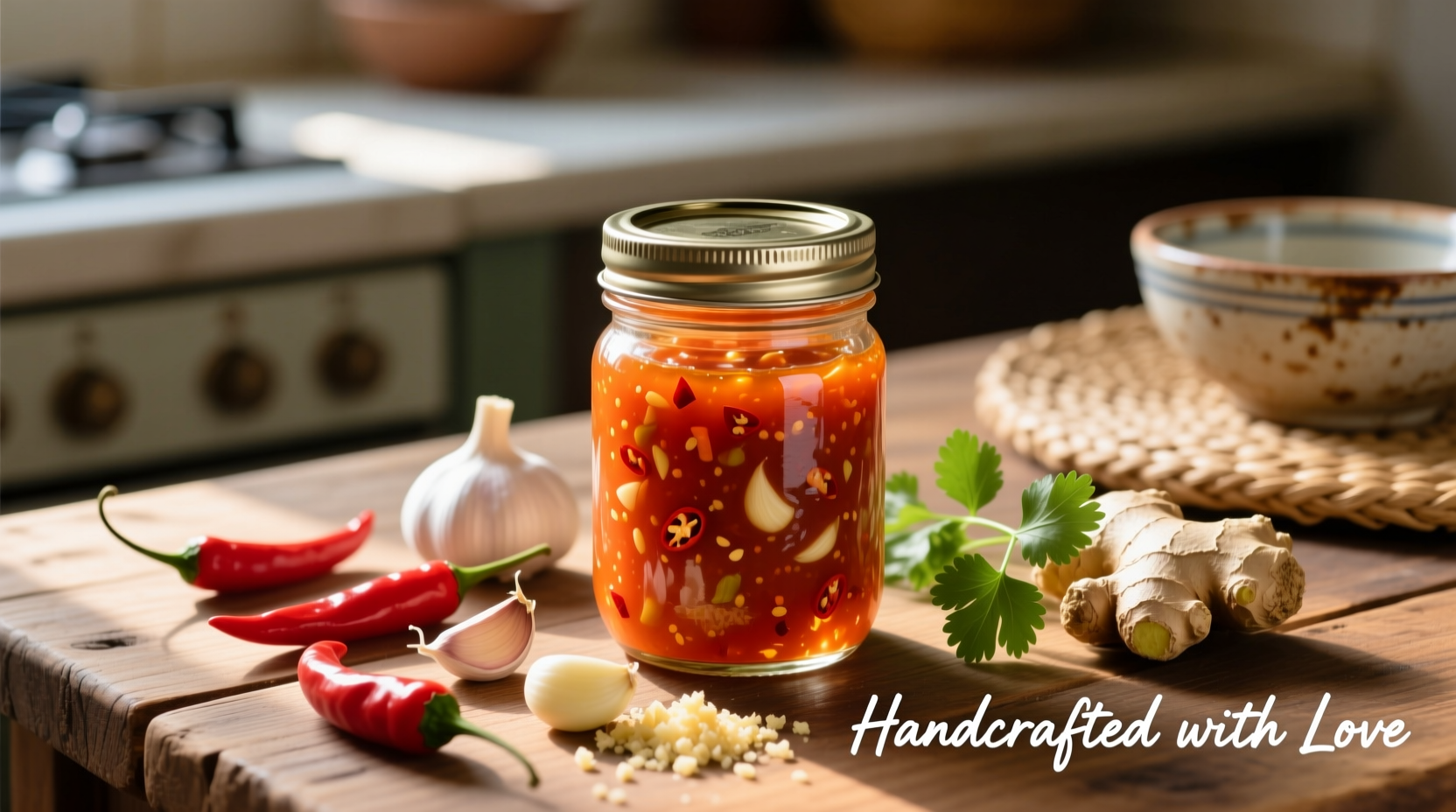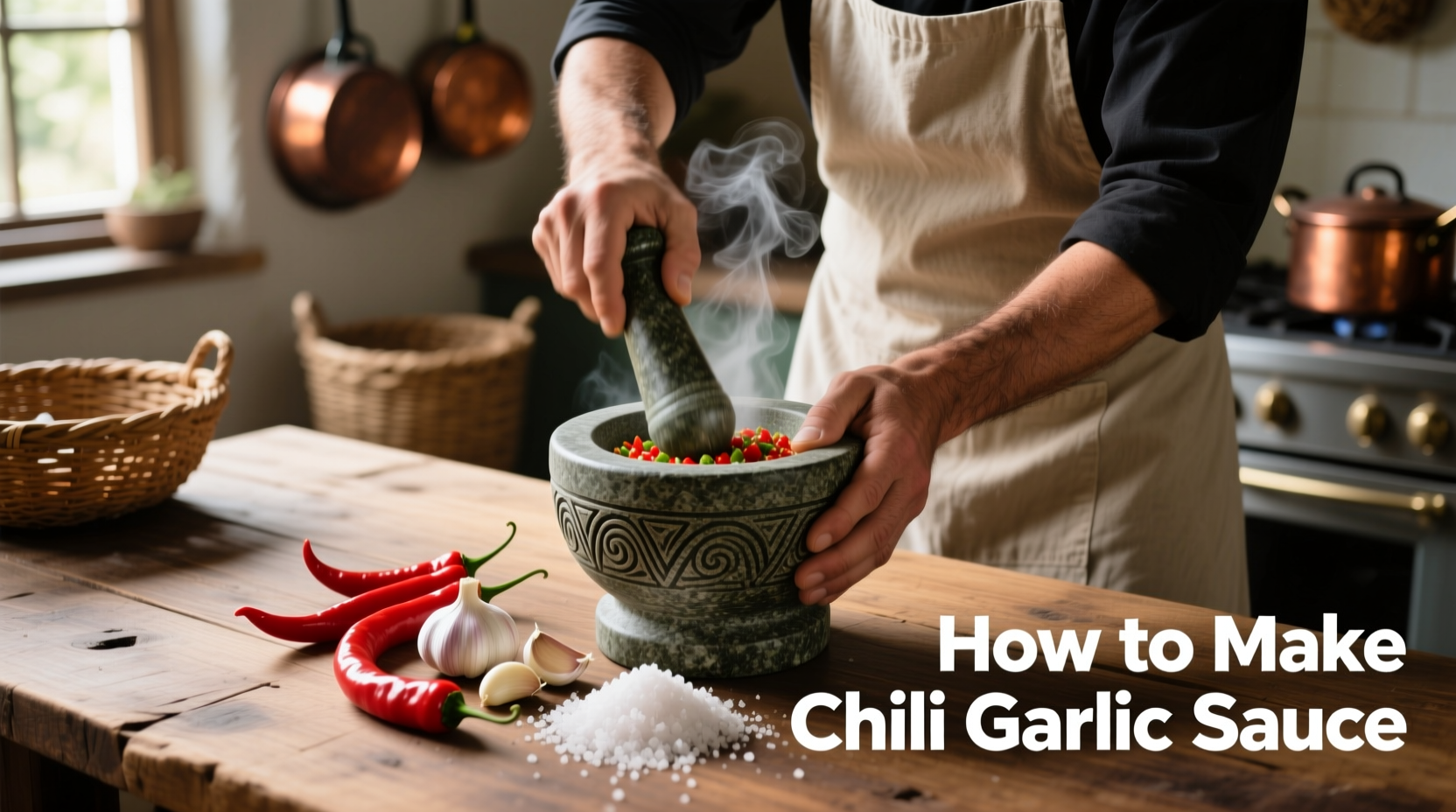Make perfect homemade chili garlic sauce in 15 minutes with just 5 ingredients: fresh red chilies, garlic, vinegar, sugar, and salt. This authentic recipe yields a vibrant, balanced sauce with customizable heat levels and no preservatives—superior to store-bought versions.
Craving that signature spicy, garlicky kick for your stir-fries, noodles, or dumplings? Forget bottled sauces filled with additives. This foolproof chili garlic sauce recipe delivers restaurant-quality flavor with complete control over ingredients and heat level. As a chef specializing in Chinese regional cuisines, I've refined this technique through decades of perfecting Sichuan and Hunan dishes where chili garlic sauce forms the flavor foundation.
Your Essential Homemade Sauce Toolkit
Before you start, gather these kitchen essentials. Having the right tools ensures smooth preparation and optimal texture:
- Food processor or mortar and pestle—for ideal chunky-smooth consistency
- Glass jar with airtight lid—essential for proper fermentation and storage
- Measuring spoons—precision matters for balanced flavor
- Rubber spatula—to scrape every bit of flavor from your bowl
Step-by-Step Sauce Creation
Follow these simple steps for authentic chili garlic sauce that elevates any dish:
- Prepare your chilies: Remove stems from 1 cup fresh red chilies (like Thai bird chilies or serranos), keeping seeds for maximum heat. Wear gloves to protect sensitive skin.
- Process garlic: Peel and roughly chop ½ cup garlic cloves. Pulse in food processor until coarsely chopped.
- Combine ingredients: Add chilies, 2 tablespoons rice vinegar, 1 tablespoon sugar, and 1½ teaspoons salt to the garlic. Pulse until desired consistency—slightly chunky works best for texture.
- Rest and develop: Transfer to glass jar, press down to eliminate air pockets, and seal tightly. Let sit at room temperature for 24 hours to allow flavors to meld.
- Store properly: Refrigerate for up to 3 months. The vinegar preserves freshness while flavors continue developing.

Regional Variations Compared
| Region | Key Ingredients | Heat Level | Best Uses |
|---|---|---|---|
| Sichuan, China | Chili flakes, fermented bean paste | ★★★★☆ | Dry-fried dishes, mapo tofu |
| Hunan, China | Fresh chilies, garlic, no vinegar | ★★★★★ | Steamed fish, rice dishes |
| Thailand | Bird's eye chilies, lime juice | ★★★☆☆ | Dipping sauces, seafood |
| California-style | Red jalapeños, roasted garlic | ★★☆☆☆ | Burgers, sandwiches |
Customize Your Flavor Profile
One advantage of homemade sauce is complete customization. Adjust these elements to match your preferences:
- Heat control: Reduce seeds for milder sauce, or add a pinch of cayenne for extra kick
- Sweetness balance: Substitute honey or palm sugar for nuanced sweetness
- Texture options: Blend longer for smooth sauce, or hand-chop for rustic texture
- Flavor enhancements: Add 1 teaspoon ginger or ½ teaspoon Sichuan peppercorns for complexity
Storage Guidelines and Shelf Life
Proper storage maintains both safety and flavor quality. According to USDA food safety guidelines, homemade chili garlic sauce stored in airtight containers in the refrigerator remains safe for consumption for 2-3 months. The vinegar content creates an acidic environment (pH below 4.6) that prevents harmful bacterial growth. Always use clean utensils when handling to prevent contamination.
For extended storage, freeze in ice cube trays then transfer to freezer bags—perfect portion sizes for future cooking. Thaw overnight in the refrigerator before use.
Perfect Pairing Suggestions
This versatile sauce enhances countless dishes. Professional chefs in Chinese kitchens use it as a flavor base rather than just a condiment. Try these authentic applications:
- Stir-fry foundation: Add 1-2 tablespoons before vegetables for deep flavor penetration
- Dipping sauce: Mix with equal parts black vinegar and a dash of sesame oil
- Noodle booster: Toss with cold sesame noodles or ramen
- Marinade base: Combine with soy sauce and Shaoxing wine for meats
- Breakfast upgrade: Swirl into congee or fried rice
Troubleshooting Common Issues
Even simple recipes encounter challenges. Here's how to fix frequent problems:
- Too spicy? Balance with additional sugar or a splash of rice vinegar
- Too thin? Add more chilies or reduce liquid ingredients next batch
- Muted flavor? Let sit longer (up to 72 hours) for flavors to intensify
- Separation occurring? Stir well before each use—natural with no emulsifiers
Evolution of Chili Garlic Sauce Through History
Understanding the historical context helps appreciate this simple condiment. Chili peppers only reached Asia through 16th century trade routes, yet became integral to regional cuisines within centuries. Chinese culinary records show garlic-based sauces existed for millennia, but the chili-garlic combination emerged after Portuguese traders introduced chilies to Southeast Asia around 1570. By the 1800s, regional variations had developed across China's provinces, each adapting to local climate and ingredient availability. Modern commercial production began in the 1970s when Thai and Chinese food gained global popularity.
When to Choose Alternative Sauces
While versatile, chili garlic sauce isn't universal. Recognize these limitations:
- Avoid in delicate seafood dishes where strong flavors overwhelm subtle notes
- Not ideal for clear broths where visual clarity matters
- Substitute with chili oil when you want heat without garlic intensity
- Use black bean sauce instead for traditional Peking duck preparation











 浙公网安备
33010002000092号
浙公网安备
33010002000092号 浙B2-20120091-4
浙B2-20120091-4